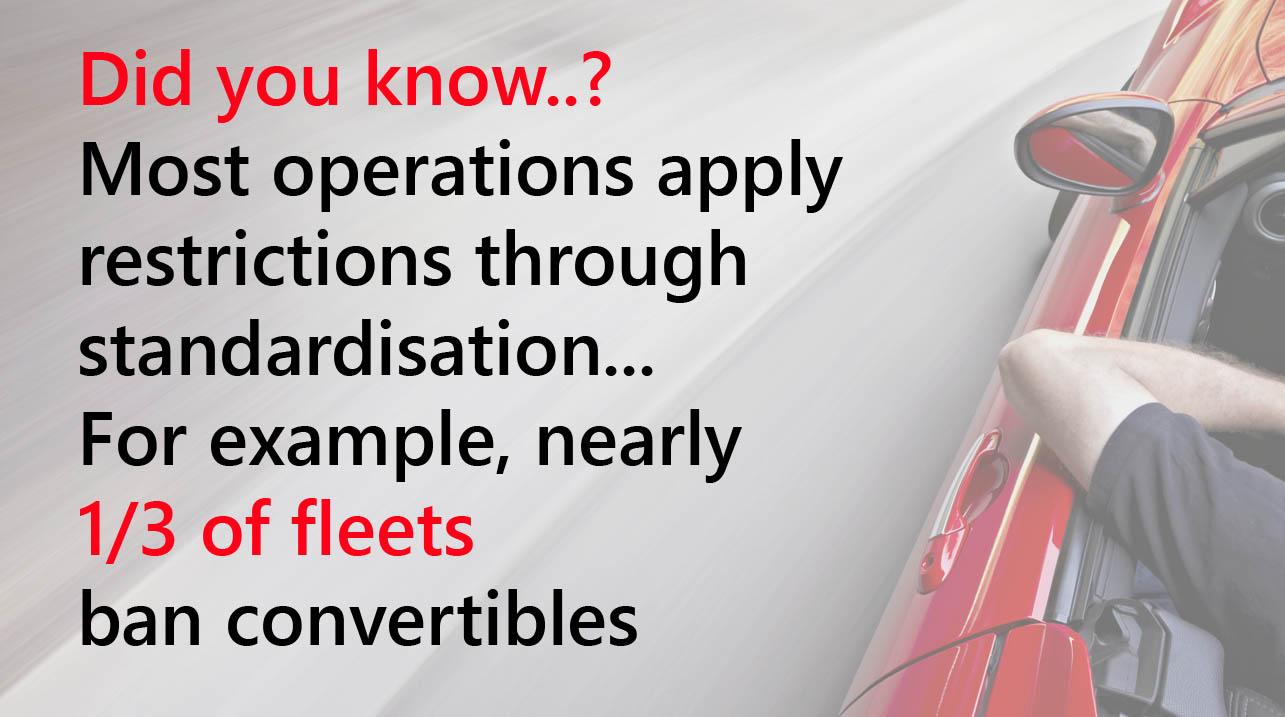Learning Zone
5 tips for selecting the best vehicles for your fleet
Make sure to choose the best fleet vehicles for the needs of your organization
It’s well-recognized that the act of procuring your vehicles will take up a major part of your budget – so it’s important to try and make the right choices when it comes to fleet vehicle selection.
.

.
Of all your fleet management responsibilities, selecting the best fleet vehicles and allocating them to suit the particular needs of your operation is sure to present one of the greatest conundrums. There can be some pretty complicated factors to consider when managing your fleet, such as pressure to determine needs and keep staff happy – while constantly striving to preserve capital and ‘achieve more with less’.
No wonder when it comes to fleet vehicle selection, one of the biggest questions we hear from fleet managers is, “how can I make the best procurement decisions?”
The best strategy involves doing your research and assessing all of the factors that could impact budget, capital expenditure decisions, leasing options and cost of ownership.
Here are our TOP FIVE things you should consider when selecting the best fleet vehicles for the needs of your company:
Use and operation
The most important thing to remember when seeking the best fleet vehicles for your operation – whether you’ll be buying, financing fleet purchases, or leasing your vehicle, first of all you’ll need to make sure you choose a vehicle that is appropriate for its intended use.
At this stage you should avoid any brand or manufacturer-specific parameters that might limit choices. Instead, focus on the required vehicle features and capabilities. Think about what it will be used for and consider things such as:
- Size, style and carrying capacity – what types and amounts of supplies, products or equipment will your vehicle carry? For example, is a traditional trunk important so that goods are out of sight, or is it more important to have a larger carrying capacity and easier access to cargo that an SUV provides?
- Routing, roads and terrains – will the vehicle be used in an urban stop-and-go environment or will it cover long distances on highways between stops? For example, if the vehicle is to be used in an off-road setting, such as a construction site, you may wish to consider a 4WD or AWD – but if it’s used for everyday urban commuting, a more compact vehicle may be preferable.
TOP TIP! Always consider downsizing if your operation really doesn’t need a bigger vehicle. By reducing unnecessary vehicle weight, you could reap valuable fuel savings.
Standardizations and specifications
Once you’ve determined the best vehicle size, type and carrying capacity, you’ll need to make some key specification choices.
You may find that standardizing some specifications can be useful when it comes to fleet vehicle selection, to help:
- Support corporate objectives and branding (remember, vehicles are a main part of a customer’s contact with your company, and they can therefore portray a certain image)
- Ensure employees are always given the most appropriate vehicles for their job roles
- Support streamlined maintenance programs, technician training and parts inventories

What kind of standardizations might you consider? Well, you could specify that vehicles must have emissions of a certain amount, or that engine sizes are capped according to job role or experience. For example, you may offer vehicles with a larger engine size to senior managers, and so on.
(Of course, on occasion it might be preferable to consider diverting from your standard specs to help meet user needs.)
TOP TIP! Selecting the right fuel and engine type for your vehicles – with careful consideration of both initial cost and cost of operation – is increasingly important. These factors should always be near the top of your spec list because fuel spend is likely to represent one of your biggest budget outlays.
More informed fuel and engine choices can improve your fuel economy, boost your company’s sustainability initiatives, curb your emissions, comply with legislation, reduce costs and more.
Traditionally one of the biggest choices faced by fleet managers was whether to use a diesel or gasoline engine. However, a growing number of alternatively-fueled vehicles are also now available to fleets. To identify the best type of engine for your operation, you should research fuel types’ pros and cons, and cross reference your findings against your requirements.
Also remember that engine downsizing can be beneficial because smaller engines tend to be more fuel-efficient.
User requests and additional extras
It’s not unusual for organizations to allow some degree of flexibility when it comes to fleet vehicle selection, in the form of additional extras and ‘perks’ designed to boost staff satisfaction.
.

.
Employee satisfaction is essential not only to customer satisfaction but for vehicle durability and efficient operation as well. However it’s important to ensure that employee demand for comfort and convenience extras is aligned with your operational objectives.
Safety
Another area to consider when making your fleet vehicle selection decision is safety. If reducing accident costs is a high priority for your fleet, then it’s worth considering vehicle technologies that are designed to enhance safety and mitigate the potential for accidents.
A thorough cost-benefit analysis of those solutions can lead to more informed choices. Plus, it’s worth considering that better accident management might go hand-in-hand with a faster return on investment and lower costs.
Maintenance and upkeep
Another large part of the cost of vehicle ownership is related to maintenance – so be sure to do your research into projected costs for a vehicle’s routine service needs, parts and labor. Then, look into warranty coverage to check how it will offset projected repair costs.
TOP TIP! It’s often useful to have discussions with user departments and actual operators of vehicles about how they will use vehicles to perform their jobs.
Embrace the opportunity to get firsthand experience from the people who will actually operate the vehicles. Get their honest opinions about how different vehicle could live up to the tasks they need to perform.
If you have fleet management software, you may also be able to use your fleet-related information to learn what vehicles work best for your operations, and why.
Other issues that will undoubtedly impact fleet vehicle replacement cycles include economic factors such as interest rates that affect financing costs; anticipated costs for new vehicles in later model years; and even the value of used vehicles on the resale market.
Conclusion
Every fleet operation is different and so this list is certainly not exhaustive. However, if you want to select the best fleet vehicles for the needs of your organization, all of these factors need to be considered and weighed against your business requirements.
Above all, remember that achieving the goal of getting the most value up front and throughout a vehicle’s service life – while providing the right equipment for the job – takes sound and accurate knowledge. With this in mind, our biggest recommendation is “always do your research”.
In terms of both capital investments and total cost of ownership, vehicles are one of the most expensive purchases your company will make on an annual basis, so it really is worth the effort to make sure you select the best fleet vehicles right from the start.



